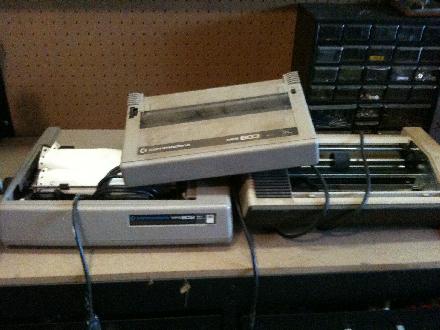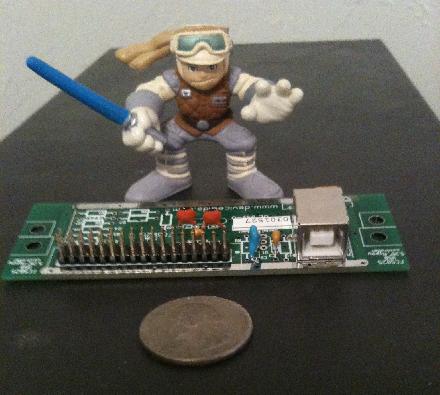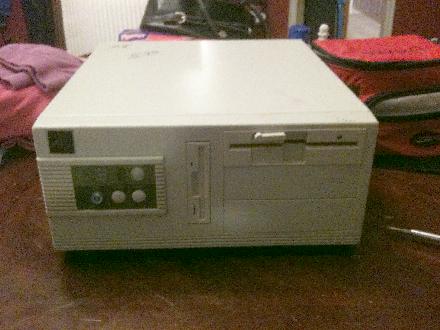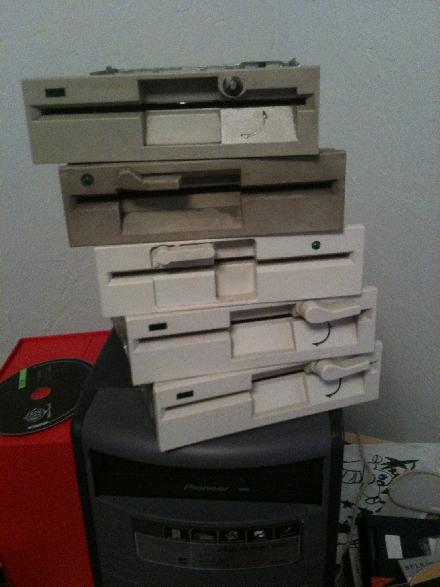I can think of three reasons why anybody would rent table space at a video game convention. The first is, you own a video game store. Those guys are there to sell games and promote their stores. The second reason is, you’re a video game collector looking to (a) sell video games (often duplicate titles from your own collection) and (b) trade video games with other vendors. And then there are people like me — people who rent table space for the sole purpose of showing off things.
At OVGE 2004 I displayed my collection of vintage console copiers (old devices used to dump cartridge ROM data to floppy disks). It was my first year as an exhibitor at OVGE, and I went all out by decorating my table with a “pirate” theme. (To this day, people at the show still refer to me as “the guy that did the pirate table”.) In 2005, I put together a Star Wars-themed table. Both years I had multiple people ask, “Yeah, but what are you selling?”

OVGE 2004: The Pirate Theme.

OVGE 2005: The Star Wars Theme.
For the 2011 show, with the public’s interest in text adventures possibly the highest it’s been in the past 20 years, I put together a display I referred to as GET TEXT. Get Text consisted of three parts: half a dozen computers running text adventures, a bunch of text adventure-related memorabilia … and Robb Sherwin (of Caltrops.com fame) who generously flew out to Oklahoma on his own dime specifically to attend OVGE 2011 and promote his new game, Cryptozookeeper.
Sherwin arrived in Oklahoma City late Friday evening. That night we ate cheap tacos and stayed up way too late talking about video games. We went to bed around 1am, and woke up a little after 5am to load up the truck and drive to OVGE in Tulsa, picking up my buddy Jeff before hitting the turnpike.
(For the record, I cannot state strongly enough how important Jeff is to the show. Jeff is the rock that allows me to roam around, talk to people, take pictures, and let my Attention Deficit Order run wild. He calms me down before the show, helps me focus, helps me set up my displays, and If I’m gone from the table too long, he puts on my name tag and signs books for people until I get back. Without Jeff, my table would consistently suck. I thank him every year for all he does, but really, if you’ve ever enjoyed any of my displays over the past five years, you should thank him too.)
Enough with the gushing; on with the display.

Not seen in this picture is my Commodore 64 system. Starting next to it, I had an Apple IIc, a DOS machine, an Amiga 600, a TRS-80 Model 4P (portable/luggable), an iPad, and a Windows 7 machine.
(Nerdy details: the Commodore alternated between running two Scott Adams games, Adventureland and The Hulk. The Apple II was running Oo-topos and
Indiana Jones in Revenge of The Ancients. The DOS machine (an Acer netbook running DOSBox; yes, I cheated) ran a couple of different text adventures, including my own game, Hangar 22. The Amiga 600 was running The Pawn and Guild of Thieves, both by Magnetic Scrolls. The TRS-80 4P ran Zork on its green screen all day long. On the iPad I had installed Frotz and was running Hangar 22. The last machine was a Windows 7 laptop, running Robb Sherwin’s Cryptozookeeper.)
When I was coming up with the theme for my table, I expected a few of the attending adults to say, “I remember those!” and for everybody else (specifically everyone under the age of 30) to point and laugh and guffaw at such old and outdated technology.
Instead, what I saw, was this:

… and this …

… and this …

Consistently throughout the day, someone was on at least one or more of the machines. Often times, the people playing the games were young children. Although I failed to capture it on film, at one point in time there were people on all six computers. Seriously, how cool is that? Surely my table was the only place in the world that day where six strangers stood side by side, pecking away at text adventures on vintage hardware.
The two machines that seemed to get the most use throughout the day were the Commodore 64, and surprisingly, the TRS-80. I think the TRS-80’s allure was its green screen and decidedly retro styling. The Commodore 64 is always a hit, and both of the games I ran on it had color graphics as well, which may have drawn people to it. The least popular platform (surprisingly) was the iPad. I’m not sure if people weren’t comfortable in picking it up, but I don’t think anybody did. Maybe they were just being polite.
Robb Sherwin and I spent much of the day talking to visitors about text adventures: about Robb’s game, about my game, and often just about old games in general. Some of the older visitors’ eyes would light up as them remembered old games they used to play. One guy mentioned the classic Broderbund title The Ancient Art of War, which we all discussed. Man, I used to play that game all the time my Dad’s IBM PC Jr. I was so terrible at that game that I’m sure Sun Tzu rolled over in his grave every time I booted it up, but boy was it fun.
Prior to the show, I advertised that I would have (a) free CDs full of text adventures to give away, or that (b) if you brought by a USB stick, I would fill it with text adventures. Due to woefully poor planning on my part, I ran out of CDs an hour into the show. I did have approximately a dozen people take me up on my USB offer, which we awesome. I also promised a couple of people that I would put the cache of text games online for download — I’ll do that tonight.
For most of the day, people of varying ages, gathered around machines, playing text adventures. If that doesn’t sound like a good time, I don’t know what does.
Thanks to Robb Sherwin for coming out and sharing his game Cryptozooker with the crowd, Jeff Martin for all the help and assistance, and Brian Green from AmigaCD32.com for loaning me his TRS-80, Amiga 600, and various software packages for the show. Without help from these three fellows, “Get Text” would have been “Get Poop”. Thanks again, guys.
For more pictures from the show, check out my 2011 OVGE Photo Album.
EDIT: Robb Sherwin wrote his own thoughts about the show over at Caltrops.















